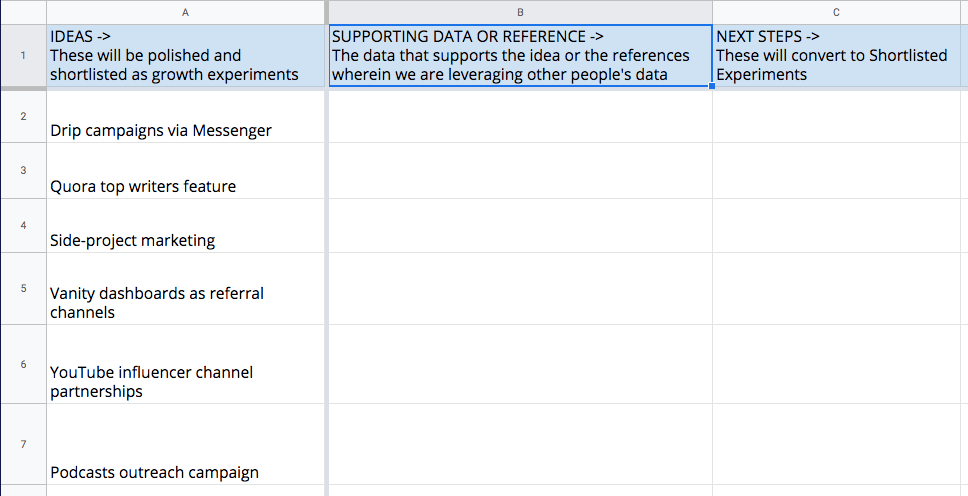As briefly explained in Chapter 3, the steps in this ideation phase include:
- Using the data from Phase 1 to list growth marketing ideas
- Fetching ideas with past data available from my database of growth marketing ideas
- Brainstorming the ideas internally and externally
- Assigning supporting data points to each idea
- Mapping each idea to the target growth metric
*Note that if you’re an experienced growth marketer, it’s very important to maintain a database of growth marketing ideas and to assign a score to them based on how they worked for you in the past.
Of course, the implementation will be different for new businesses or startups you work with but this will give you an idea over time how your ideas performed.
If you’re new or want to boost your growth marketing idea bank, you can get the 101 growth ideas ebook here.
Next, the supporting data points must be assigned to each idea as shown in my template below:

As you can see in the ideation template, we have the following columns in this phase:
- IDEAS
- SUPPORTING DATA OR REFERENCE
- NEXT STEPS
The output of this phase is coming up with the first set of growth experiment ideas.
You can start with as many ideas as you like – I usually like to work with 10 ideas in the first cycle of Ideation.
The ideas are documented based on past data, channel personas, and marketing ideas.
Channel personas are characteristics of the potential new channels we can explore for growth marketing campaigns as we start thinking outside of the most popular channels.
Growth marketing is effective when we execute creative experiments on popular channels and it’s also effective when we execute regular experiments on offbeat channels.
The reasons for going beyond the popular channels are as follows:
- The most popular channels are expensive and saturated
- There are higher chances for successful growth hacking experiments in channels that are in the early-adopters stage
- A channel’s effectiveness typically reduces over time
- Offbeat and new channels are mostly cheaper than saturated ones, thus reducing investment and increasing the growth marketing ROI
- Multiple micro-channels mapped with the Target Audience are better than a single macrochannel with no TA focus
- It’s easier to target the right user segment with micro-channels VS paying for targeting on Facebook or other larger channels
- A new or offbeat channel probably has loopholes that Growth Marketers can leverage compared to a mature channel
A few questions to help create the channel personas business are as follows:
- Q1. What kind of problem would the channel solve for a similar target audience as yours?
- Q2. What are the other interests of your target audience? Where do people with similar interests hang out online?
- Q3. What are some of the other brands, products, or tools your audience follows on social media?
- Q5. What are the new channels which have been trending on Google Play or the App Store for the past few weeks?
- Q6. What are the new communities or networks on ProductHunt or BetaList?
- Q7. Which platforms and marketplaces have recently received PR or funding?
- Q8. Which tools or networks are review bloggers in my network also writing about?
Though this is not an exhaustive list, it’ll give you an understanding of how to come up with growth marketing experiments.
In the next chapter, we will discuss the EXPERIMENTATION phase of growth marketing.